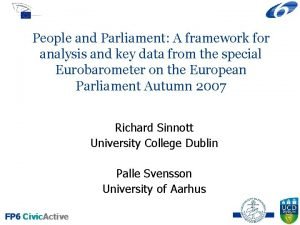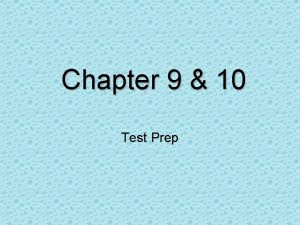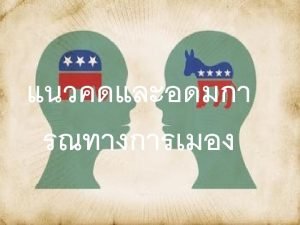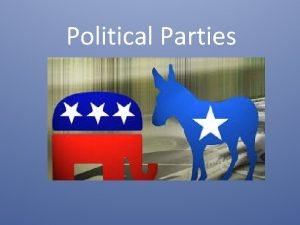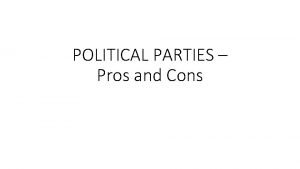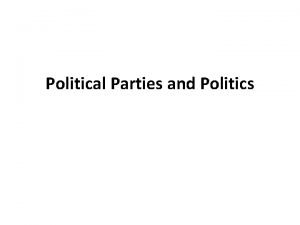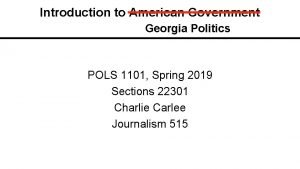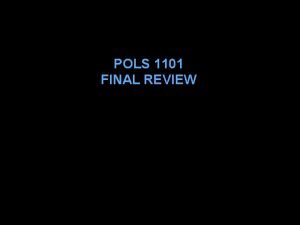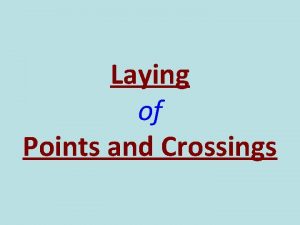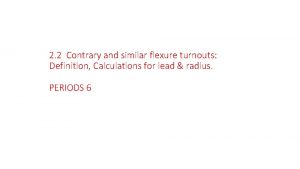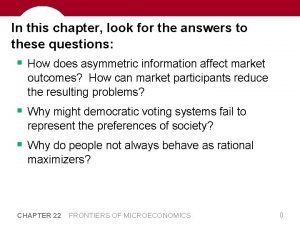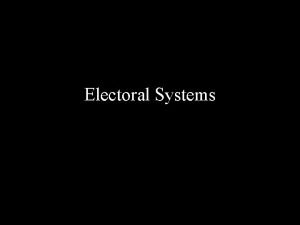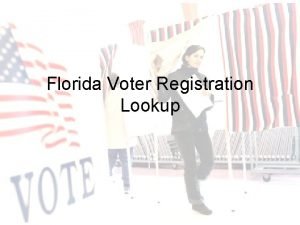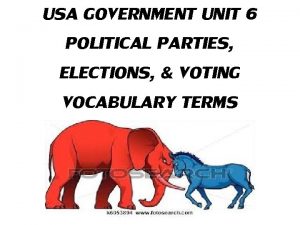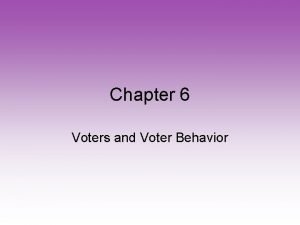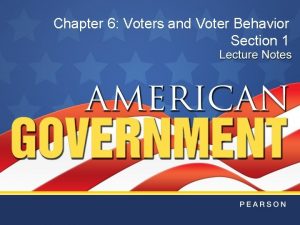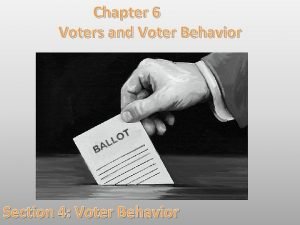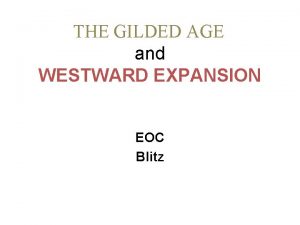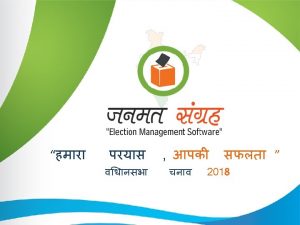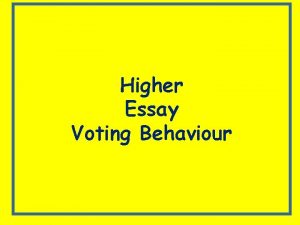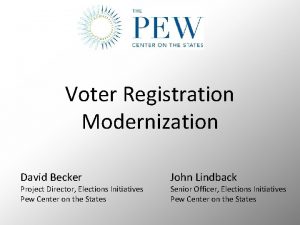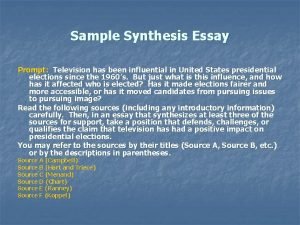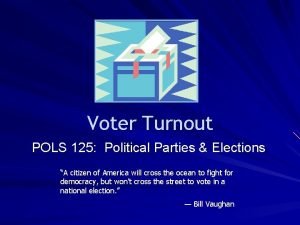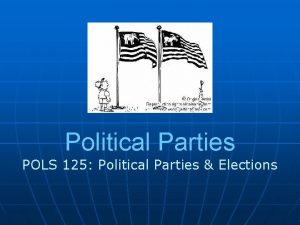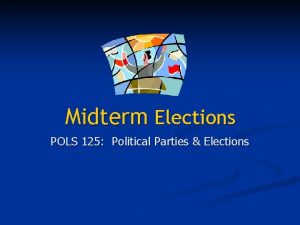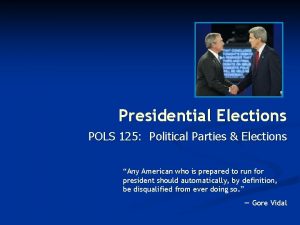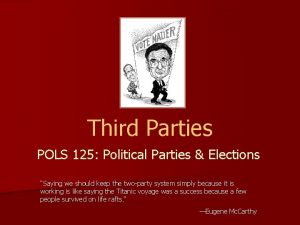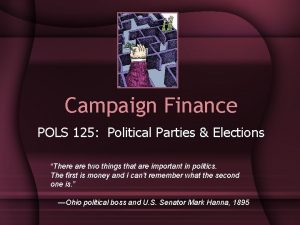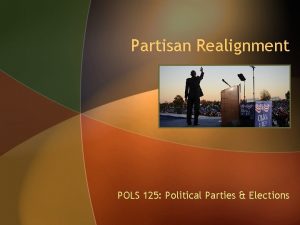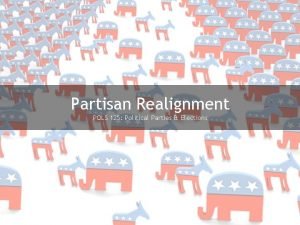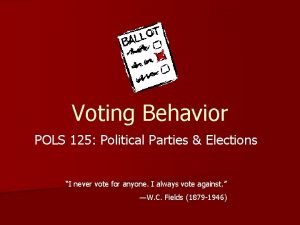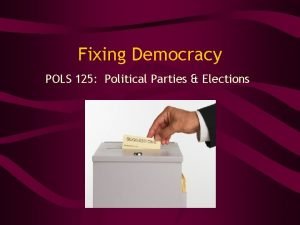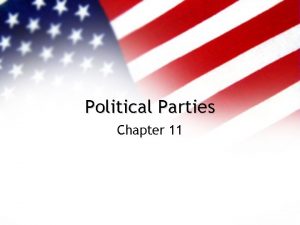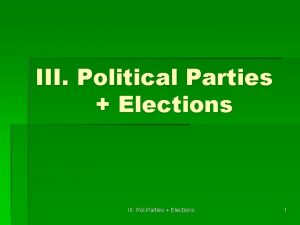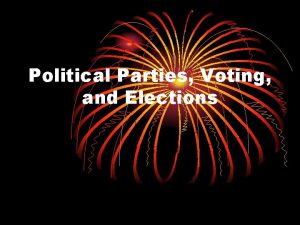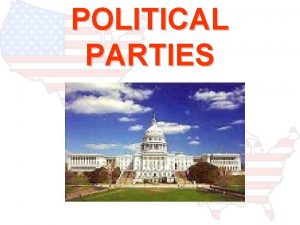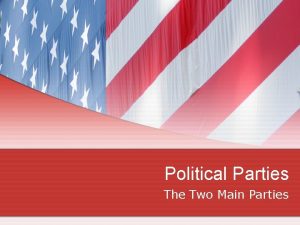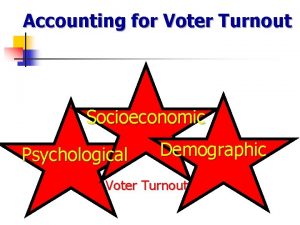Voter Turnout POLS 125 Political Parties Elections A


























- Slides: 26

Voter Turnout POLS 125: Political Parties & Elections “A citizen of America will cross the ocean to fight for democracy, but won't cross the street to vote in a national election. ” — Bill Vaughan

The Vanishing Voter Patterson calls declining voter turnout “the longest sustained downturn in American history. ” What factors have caused it? Generational replacement Lack of competitive elections Weakening party loyalty

This is all the more disturbing because turnout should have increased… Increasing educational attainment Removal of poll taxes and literacy tests Simplified registration procedures

Voter Turnout in 2008 In November 2008, 131 million votes were cast for president. Is that number high or low? low It depends on how turnout is measured…

How Should We Measure Turnout? Turnout statistics can use any of three denominators: The voting-age population (VAP) includes non-citizens and felons who are ineligible to vote, and excludes expatriate citizens who could legally vote overseas. VAP estimates provide the lowest turnout levels because they underestimate actual turnout. The voting-eligible population (VEP) starts with the voting -age population, then subtracts disenfranchised felons and non-citizens, and adds citizens from overseas. VEP estimates of voting turnout are higher than VAP estimates. The number of registered voters includes only those legally registered to vote. This provides the highest rate of voter turnout.

How Should We Measure Turnout? VAP VEP REG 131 million votes cast 231 million voting age citizens = 57% voter turnout 131 million votes cast = 62% voter turnout 213 million voting eligible citizens 131 million votes cast 172 million registered voters = 76% voter turnout Fraud?

If voter turnout is low, compared to what? Compared to other countries Compared to historic rates of voter turnout in the United States

Voter Turnout in the United States Compared to Other Countries Source: International IDEA, http: //www. idea. int/vt/survey/

Voter Turnout in Presidential Elections, 1828 -2008

Voter Turnout in Presidential Elections, 1828 -2008 The 26 th Amendment grants 18 -20 year olds the right to vote The 19 th Amendment grants women the right to vote

Voter Turnout in Presidential Elections, 1828 -2008

How Should We Measure Turnout?

Increasing Voter Turnout OPTION #1: Do nothing. Once we use the appropriate measure (e. g. , VEP), there is no problem. OPTION #2: Do nothing. Turnout may be low, but we don’t want uneducated, uninformed people voting anyway. OPTION #3: Do nothing. Voter and non-voters have similar policy preferences, so it makes little difference OPTION #4: Do something! Voting by mail Voting early Internet voting Election day registration

Does Low Voter Turnout Matter? Should we prefer a: Smaller, more highly educated, less representative electorate? Larger, less well educated, more representative electorate?

Increasing Voter Turnout OPTION #1: Do nothing. Once we use the appropriate measure (e. g. , VEP), there is no problem. OPTION #2: Do nothing. Turnout may be low, but we don’t want uneducated, uninformed people voting anyway. OPTION #3: Do nothing. Voter and non-voters have similar policy preferences, so it makes little difference OPTION #4: Do something! Voting by mail Voting early Internet voting Election day registration

Why Don’t People Vote? Institutional context Motor-Voter Compulsory voting Election Day registration Voting by mail Internet voting Motivational strategies Personal canvassing Social pressure Enduring personal traits and orientations psychological Socialization through programs such as Kids Voting USA

How Does Motor-Voter Work? Widely known as Motor-Voter, the National Voter Registration Act of 1993 is designed to encourage voter registration and to remove discriminatory and unfair obstacles to voter registration. As of January 1, 1995, the law requires states to register voters for federal elections in three specific ways, in addition to any other procedures they use currently for registering voters: 1. Simultaneous application for driver’s license and voter registration 2. Mail application for voter registration 3. Application in person at certain government agencies, including public assistance offices and agencies that provided services to people with disabilities

The Problem with Motor-Voter Registration Voter Turnout Motivation and/or interest in politics

Why Don’t People Vote? Institutional context Motor-Voter Compulsory voting Election Day registration Voting by mail Internet voting Motivational strategies Personal canvassing Social pressure Enduring personal traits and orientations psychological Socialization through programs such as Kids Voting USA

Vote Mobilization Efforts to increase voter turnout are often called “Get-Out-the-Vote” drives, or GOTV.

Obama goes door-to-door in Iowa DES MOINES, Iowa - Democrat knocked on doors in the Iowa capital Saturday talking up his opposition to the war in Iraq. At one stop, Obama got a warm welcome from a woman who said the visit might persuade her to attend the Democratic presidential caucus in January, "I'm flabbergasted that he's here knocking on my neighborhood door, " Jody Degard told reporters after the visit from the Illinois senator.

Voter Turnout as a Political Strategy With narrow margins of victory, and an electorate split evenly down the middle, political parties increasingly battle over voter turnout.


Vote Suppression Ballot and machine shortages on Election Day in selected precincts. Delays in sending absentee ballots. Vote challenges. Disqualification of provisional ballots. Purges of voter registration lists (e. g. , voter caging). Misdirection of voters to polling places. Negative advertising designed to undermine morale.

Has Motor-Voter Increased Ballot Fraud? Nashawna Prude, 9, with a family photo that includes her grandmother, Kimberly, second from left, jailed for more than a year for voter fraud. Kimberly Prude was convicted of voting while on probation, an offense that she attributes to confusion over eligibility.

The Debate over Photo IDs “It's outrageous to hear my colleagues sit there and say that the Republican Party is embarking on a move to suppress the vote of ethnic minorities throughout the country. That is blatantly false. I am not going to sit here and by my silence give any credence to that assertion. That's ridiculous. " —Rep. John Doolittle (R-CA)
 European parliament voter turnout
European parliament voter turnout What was one way progressives differed from populists
What was one way progressives differed from populists Soup and ideology
Soup and ideology Political parties
Political parties Political parties
Political parties The supreme court change
The supreme court change Political parties pros and cons
Political parties pros and cons Win the white house brainpop
Win the white house brainpop A political party is an association of
A political party is an association of Shanshan lian uga
Shanshan lian uga Pols 1101 final exam
Pols 1101 final exam Letak nadi perifer
Letak nadi perifer Steunverband pols
Steunverband pols 1 in 16 turnout sleeper spacing
1 in 16 turnout sleeper spacing Similar flexure turnout
Similar flexure turnout Median voter theorem
Median voter theorem Median voter theorem
Median voter theorem Florida voter registration lookup
Florida voter registration lookup Cross-pressured voter definition government
Cross-pressured voter definition government Chapter 6 voters and voter behavior
Chapter 6 voters and voter behavior Chapter 6 section 1 the right to vote
Chapter 6 section 1 the right to vote Chapter 6 section 4 voter behavior
Chapter 6 section 4 voter behavior Gained voter support by helping immigrants find jobs.
Gained voter support by helping immigrants find jobs. Voter parchi software
Voter parchi software Higher modern studies voting behaviour essay
Higher modern studies voting behaviour essay David becker elections
David becker elections Ap lang synthesis essay television presidential elections
Ap lang synthesis essay television presidential elections
